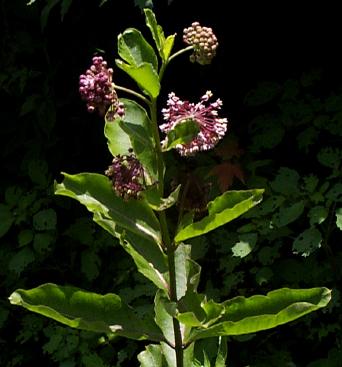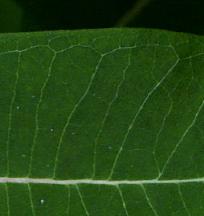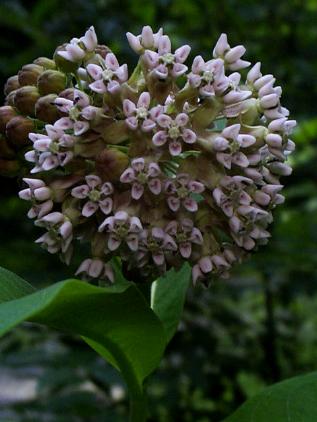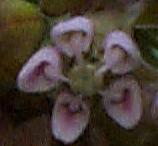|

|
HOME
Botanical
Terms
 Lists:
Master Plant
List
Flowering Times
List
Flowers by
Color/Type
Endangered
Species List
Habitat
List
Lists:
Master Plant
List
Flowering Times
List
Flowers by
Color/Type
Endangered
Species List
Habitat
List
Use the 'back' button on your browser to return, if
necessary.
|
|
 Also found along
forest margins where the light is good.
Also found along
forest margins where the light is good.
|
FAMILY:
Milkweed Family (Asclepiadaceae)
DESCRIPTION:
A tall (3 - 6') rhizome-spreading plant
with slightly drooping purplish to pink flower
clusters, 2 - 3 inches in diameter. The plant is
unbranched, with broadly oval leaves.
FLOWERS:
June to August
HABITAT:
Old fields, fencerows, roadsides and
waste places.
|

|
The veining of the leaves
have a characteristic wavy margin line.
|
|
OTHER INFORMATION:
Milkweed gets its name from the milky
sap it oozes when bruised or broken (leaves, stems
and flowers).
|

|
Closeup
of the flower shows an intricate pattern
of 5 petals and a 5-part central
crown.

|
The 'milk' contains cardiac glycosides,
possibly related to digitalis which is used in
treating heart disease. Several insect and insect
larvae (Milkweed bug, monarch butterfly, etc.) feed
almost exclusively on this plant and thus become
toxic to birds and other predators. Interestingly,
the insects display their toxicity with strong
patterns of black and orange (One of natures
warning flags). In parts of Appalachia, the milky
sap is used to treat warts and moles.
|
OTHER OBSERVATIONS:
My observations about this plant can be found at:
OFFSITE INFORMATION:
If you're interested in the California varieties, try the
California
Academy's website.
A more scientific addressing of the milkweed and the
whole family is at
Cornell
Universities site.
|
|
![]()
![]()
![]()
![]()
![]()